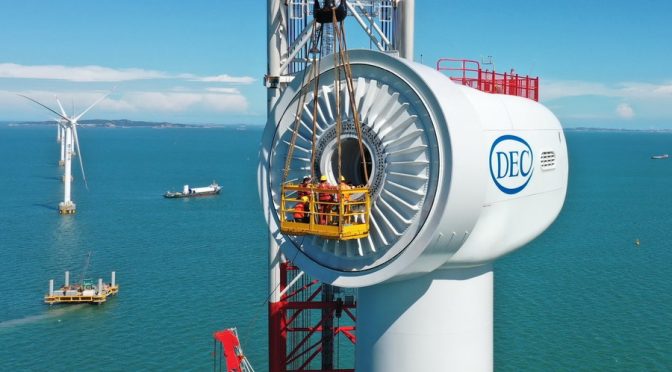The first Sino-foreign joint venture offshore wind power project in China started to generate electricity in east China’s Jiangsu Province on Saturday.
The joint venture constructed and operated by CNH Energy and French multinational utility company EDF has realized full capacity power generation with a total installed capacity of 500,000 kilowatts.
After being put into operation, the annual power generation is expected to reach 1.39 billion kilowatt hours, which can meet the annual power demand of 2 million residents, equivalent to cutting the emissions of 441,900 tons of standard coal, 937,500 tons of carbon dioxide and 1,704 tons of sulfur dioxide.
As of the end October, China’s accumulative installed capacity for renewable energy reached one billion kilowatts, doubling that in the end of 2015, according to the National Energy Administration.
The share of renewable energy now accounts for 43.5 percent of the total installed capacity of power generation in China, up 10.2 percentage points over the end of 2015.
Among renewable power sources, the installed capacity of hydropower, wind power, solar power and biomass power generation have reached 385 million kilowatts, 299 million kilowatts, 282 million kilowatts and 35.34 million kilowatts respectively, ranking first in the world.
China could offer developing countries pathways to transition from fossil fuels to clean energy, a senior environmental policymaker has said.
Li Junfeng, founding director of the National Centre for Climate Change Strategy and International Cooperation (NCSC), said China should not only think about its own energy transition but also work with developing countries on their carbon neutrality goals.
Many breakthrough energy technologies of the past five decades, in nuclear and solar power, for instance, had been commercialised in China, Li told an environmental conference in Beijing on Wednesday.
“So we can set up programmes, together with developed countries, to help their energy transition, including countries in the Belt and Road Initiative and South-South cooperation programme,” he said.
Li is senior adviser to the NCSC, a national institute affiliated with the Ministry of Ecology and Environment.
As an expert on environmental and energy policies, Li helped draft China’s national climate change action plan and its renewable energy law, and has been a lead author of the country’s UN climate assessment reports.
While China is the world’s No 1 producer of greenhouse gases, it is also a leader in renewable energy development.
Nearly 80 per cent of the world’s solar panels are made in China. Between 2008 and 2013, China’s fledgling solar-electric panel industry helped global costs of the energy to drop by 80 per cent, according to Scientific American.
China vows carbon neutrality by 2060 during one-day UN biodiversity summit
China also built more new wind farm capacity in 2020 than the world combined the year before, according to a Bloomberg New Energy Finance report earlier this year. A separate report said the country would account for almost half of the world’s cumulative onshore wind capacity by 2030, up from about 40 per cent this year.
“About half the wind power products in developed countries are made in China, not by Chinese companies but by Chinese factories of multinational conglomerates,” Li said. “They were made in China and then sold abroad.”
As for nuclear energy, China is currently the only country capable of mass-producing third-generation reactors. A few of these are already in operation in the country, including the Hualong One. The reactor, at the Fuqing nuclear power plant in southeastern Fujian province, began commercial operations in January.
“Energy transition around the world has the same goal, which is to reduce carbon dioxide emissions. The transition is not just about cutting coal consumption but also reducing oil and gas consumption,” Li said.
“If countries were to achieve carbon neutrality around mid-century, their pathways should be basically the same – to include a high percentage of non-fossil fuels in their energy mix. The technologies are highly consistent, so we should pay attention to experience sharing and international collaboration.”
Khondaker Golam Moazzem, a research director at the Centre for Policy Dialogue in Dhaka, Bangladesh, said that since countries like China, Germany, Britain and the United States were leaders in renewable energy production, they could help support developing nations in adopting renewables in the transition.
“Renewables are a principle option for energy security for the people at this moment,” he said.
Wind and solar energies account for just 3 per cent of electricity production in Bangladesh, far below its target of raising the share of renewables in the energy mix to 10 per cent by the year-end.
“China is a major investor in Bangladesh and a major contributor to its development. We expect China has the ability to offer a long-term package solution for clean energy for Bangladesh, and that will include not only power generation, but also renewable-energy-based transmission and distribution,” Moazzem said.
“We also understand that, at least for some period of time, energy security would be based on fossil fuels. But we are actually expecting … [countries] supporting Bangladesh to move towards clean energy.”


